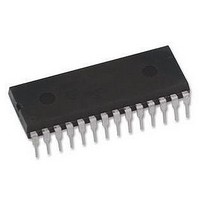ATMEGA168PA-PU Atmel, ATMEGA168PA-PU Datasheet - Page 146

ATMEGA168PA-PU
Manufacturer Part Number
ATMEGA168PA-PU
Description
MCU, 8BIT, AVR, 16K FLASH, 28PDIP
Manufacturer
Atmel
Datasheet
1.ATMEGA48A-PU.pdf
(566 pages)
Specifications of ATMEGA168PA-PU
Controller Family/series
Atmega
No. Of I/o's
23
Eeprom Memory Size
512Byte
Ram Memory Size
1KB
Cpu Speed
20MHz
No.
RoHS Compliant
Core Size
8bit
Program Memory Size
16KB
Oscillator Type
External, Internal
Rohs Compliant
Yes
Available stocks
Company
Part Number
Manufacturer
Quantity
Price
Company:
Part Number:
ATMEGA168PA-PU
Manufacturer:
TI
Quantity:
1 240
- Current page: 146 of 566
- Download datasheet (23Mb)
17.2.1
17.2.2
17.3
17.4
8271C–AVR–08/10
Timer/Counter Clock Sources
Counter Unit
Registers
Definitions
The Timer/Counter (TCNT2) and Output Compare Register (OCR2A and OCR2B) are 8-bit reg-
isters. Interrupt request (shorten as Int.Req.) signals are all visible in the Timer Interrupt Flag
Register (TIFR2). All interrupts are individually masked with the Timer Interrupt Mask Register
(TIMSK2). TIFR2 and TIMSK2 are not shown in the figure.
The Timer/Counter can be clocked internally, via the prescaler, or asynchronously clocked from
the TOSC1/2 pins, as detailed later in this section. The asynchronous operation is controlled by
the Asynchronous Status Register (ASSR). The Clock Select logic block controls which clock
source he Timer/Counter uses to increment (or decrement) its value. The Timer/Counter is inac-
tive when no clock source is selected. The output from the Clock Select logic is referred to as the
timer clock (clk
The double buffered Output Compare Register (OCR2A and OCR2B) are compared with the
Timer/Counter value at all times. The result of the compare can be used by the Waveform Gen-
erator to generate a PWM or variable frequency output on the Output Compare pins (OC2A and
OC2B). See
set the Compare Flag (OCF2A or OCF2B) which can be used to generate an Output Compare
interrupt request.
Many register and bit references in this document are written in general form. A lower case “n”
replaces the Timer/Counter number, in this case 2. However, when using the register or bit
defines in a program, the precise form must be used, i.e., TCNT2 for accessing Timer/Counter2
counter value and so on.
The definitions in
Table 17-1.
The Timer/Counter can be clocked by an internal synchronous or an external asynchronous
clock source. The clock source clk
bit in the ASSR Register is written to logic one, the clock source is taken from the Timer/Counter
Oscillator connected to TOSC1 and TOSC2. For details on asynchronous operation, see
– Asynchronous Status Register” on page
”Timer/Counter Prescaler” on page
The main part of the 8-bit Timer/Counter is the programmable bi-directional counter unit.
17-2 on page 147
ATmega48A/48PA/88A/88PA/168A/168PA/328/328
BOTTOM
MAX
TOP
”Output Compare Unit” on page 147
Definitions
T2
The counter reaches the BOTTOM when it becomes zero (0x00).
The counter reaches its MAXimum when it becomes 0xFF (decimal 255).
The counter reaches the TOP when it becomes equal to the highest value in the
count sequence. The TOP value can be assigned to be the fixed value 0xFF
(MAX) or the value stored in the OCR2A Register. The assignment is depen-
dent on the mode of operation.
).
Table 17-1
shows a block diagram of the counter and its surrounding environment.
are also used extensively throughout the section.
T2
157.
is by default equal to the MCU clock, clk
165. For details on clock sources and prescaler, see
for details. The compare match event will also
I/O
. When the AS2
”ASSR
Figure
146
Related parts for ATMEGA168PA-PU
Image
Part Number
Description
Manufacturer
Datasheet
Request
R

Part Number:
Description:
Manufacturer:
Atmel Corporation
Datasheet:

Part Number:
Description:
Manufacturer:
Atmel Corporation
Datasheet:

Part Number:
Description:
Manufacturer:
ATMEL Corporation
Datasheet:

Part Number:
Description:
IC AVR MCU 16K 20MHZ 32TQFP
Manufacturer:
Atmel
Datasheet:

Part Number:
Description:
IC AVR MCU 16K 20MHZ 32-QFN
Manufacturer:
Atmel
Datasheet:

Part Number:
Description:
IC AVR MCU 16K 20MHZ 28DIP
Manufacturer:
Atmel
Datasheet:

Part Number:
Description:
MCU AVR 16K FLASH 15MHZ 32-TQFP
Manufacturer:
Atmel
Datasheet:

Part Number:
Description:
MCU AVR 16K FLASH 15MHZ 32-QFN
Manufacturer:
Atmel
Datasheet:

Part Number:
Description:
IC AVR MCU 16K 20MHZ 32TQFP
Manufacturer:
Atmel
Datasheet:

Part Number:
Description:
MCU AVR 16KB FLASH 20MHZ 32QFN
Manufacturer:
Atmel
Datasheet:

Part Number:
Description:
MCU AVR 16KB FLASH 20MHZ 32TQFP
Manufacturer:
Atmel
Datasheet:

Part Number:
Description:
IC MCU AVR 16K FLASH 32-QFN
Manufacturer:
Atmel
Datasheet:











